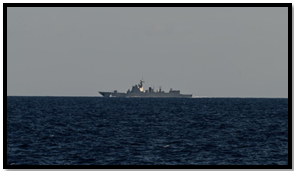THE LARGER MESSAGE TO NEW DELHI FROM THE RED SEA
Relevance:
GS 2
Bilateral, regional and global groupings and agreements involving India and/or affecting India’s interests.
Why in News:
Indian Navy deployed the guided missile destroyers, INS Mormugao, INS Kochi and INS Kolkata in the broader region.
Source- The Hindu
India’s pivot from continental to maritime strategy marks a significant shift, seeking liberation from the geopolitical complexities posed by neighboring countries like China and Pakistan. The region, however, is morphing into a new theatre of conflict and strategic maneuvering.
Recent Developments and India’s Response:
- Recent Houthi terror attacks on commercial vessels in the Red Sea prompted immediate diplomatic and military responses from India, indicating the volatile nature of the region.
- The attacks underline the broader fragility and emerging challenges in the Indo-Pacific, pressing India to reassess its maritime strategy beyond immediate counteractions.
India’s Maritime Strategy and Long-term Vision:
- Strategic Pivot to Maritime Domain: India’s maritime strategy marks a significant shift from continental preoccupations, focusing on securing its extensive coastline, safeguarding maritime trade routes, and enhancing its presence in the Indian Ocean Region (IOR).
- Enhanced Naval Capabilities: Prioritizing the modernization of the Indian Navy through the acquisition of advanced platforms like aircraft carriers, submarines, and multi-role vessels to maintain a formidable maritime force capable of ensuring regional security.
- Diplomatic Engagements and Alliances: Actively engaging in diplomatic initiatives and forming strategic partnerships with key global and regional players, exemplified by the Quad alliance and bilateral agreements, to counterbalance the rising influence of rival powers in the maritime domain.
- Securing Maritime Trade Routes: Ensuring the safety and security of critical sea lanes of communication (SLOCs) that are vital for India’s trade and energy imports, thereby bolstering economic security and regional stability.
- Indo-Pacific Focus and Regional Leadership: Asserting a leadership role in the Indo-Pacific region, advocating for a free, open, and inclusive order, and promoting maritime cooperation through initiatives like the Security and Growth for All in the Region (SAGAR) doctrine.
China’s Expanding Maritime Influence:
- India faces a dual challenge not just from Pakistan and China on the continental front but also in its maritime domain.
- China’s assertive maritime and continental postures represent a two-front challenge, with Beijing extending its influence across key maritime locations, signaling a containment strategy against India.
- The rapid expansion of the Chinese Navy and its push for overseas military bases in strategic locations like Djibouti, Gwadar, and Hambantota signal a clear intent to establish a dominant maritime presence.
- This expansion, alongside China’s growing global outreach and investments, poses a direct challenge to India’s traditional sphere of influence in the Indo-Pacific and beyond.
Strategic Directions for India:
- Capitalizing on Global Focus: India should harness the international spotlight on the Indo-Pacific to build alliances and counter China’s maritime ambitions.
- Building Robust Partnerships: Strategic collaborations, beyond symbolic initiatives, are crucial for India to address the multifaceted challenges posed by China.
- Comprehensive Strategy Formulation: India needs a well-structured maritime strategy, combining diplomatic, military, and economic elements, to ensure its long-term security and influence.
- Navigating the Dual Threat: The two-front challenge, encompassing both continental tensions and maritime threats, demands a balanced, proactive approach from India.
The Red Sea incident, while a transient concern, underscores the broader strategic challenges facing India in both its continental and maritime domains. A comprehensive, forward-looking approach, leveraging international partnerships and investing in strategic capabilities, is crucial for India to navigate this complex geopolitical landscape effectively.
| Red Sea
Source: Britanica · Location: Positioned as an inlet of the Indian Ocean nestled between Africa and Asia. · Salinity: Noted as one of the world’s most saline bodies of water. · Bordering Nations: Surrounded by Egypt, Saudi Arabia, Yemen, Sudan, Eritrea, and Djibouti. · Southern Connection: Links to the Indian Ocean via the Bab el Mandeb Strait and the Gulf of Aden. · Northern Features: Bounded by the Sinai Peninsula, Gulf of Aqaba, and Gulf of Suez, leading into the Suez Canal. · Geological Aspect: Forms a segment of the expansive Great Rift Valley, specifically the Afro-Arabian Rift Valley |
Source
The Hindu
Mains Question
Q Evaluate the strategic implications of the evolving geopolitical dynamics in the Indo-Pacific region, with a focus on India’s response to the emerging maritime and continental challenges. Discuss the necessary elements of a comprehensive maritime strategy for India in light of recent incidents and the increasing influence of major powers in the region.

 Source- The Hindu
Source- The Hindu

